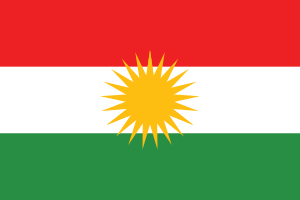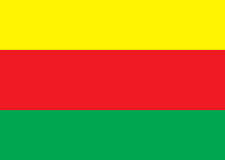Flag of Kurdistan
 | |
| Name | Alaya Rengîn ("The Colorful Flag")[1] (also Boushera Zere) |
|---|---|
| Adopted | 1927–1930 by Republic of Ararat 17 December 1945 by Republic of Kurdistan since 1992 by Iraqi Kurdistan |
| Design | Red, Yellow, Green and white with sun disk ("Rozh" "Roj" "Roush") having 21 rays, equal in size and shape. The number 21 holds importance in the ancient Yazdani religious traditions of the Kurds |
| Part of a series on Kurdish history and culture |
 |
|
Medieval history |
|
Modern history
|
|
Culture
|
The Flag of Kurdistan (Kurdish: Alay Kurdistan or Alaya Kurdistanê, ئاڵای کوردستان, also called Alaya Rengîn "The Colorful Flag") first appeared during the movement for Kurdish independence from the Ottoman Empire. Consisting of a tricolor of red, white, and green horizontal bands with a yellow sun disk of 21 rays at its center, it is currently the official flag of the autonomous Kurdistan Region in Iraq, which is under the control of the Kurdistan Regional Government. This flag is banned in Iran, Turkey and Syria[2]
The flag resembles an earlier version created by the Xoybûn (Khoyboon) organization, active in the Ararat rebellion of 1930,[2] and flown by the break-away Republic of Ararat during the period 1927-1931. The current flag appeared then again in 1932 and it was the cover of the kurdish magazine Hawar by Celadet Ali Bedirxan one of the founders of Xoybun. " Ala kurdan, ji jor ber bi jêr ve, ser hev, sor, sipî û qesq e, di nava wê de roj diçirise" the kurdish flag is red, white and green with a sun in the middle that's how Celadet Ali Bedirxan described the flag.[3][4] A similar flag was later used by the Soviet-backed Kurdish Republic known as the Republic of Mahabad in 1946.
The main characteristic of the flag is the blazing golden sun emblem (called a Roj) at its center. The emblem's sun disk has 21 rays, equal in size and shape. 21 is a venerated number, standing for rebirth/renaissance in the ancient and native Kurdish religion of Yazdanism and its modern offshoots, Yezidism, Yarsanism, and Alevism.[5]
The symbolism of the colors is:
- Red symbolizes the blood of Kurdish martyrs, the continued struggle for freedom and dignity and brotherhood;
- Green expresses the beauty and the landscapes of Kurdistan, life and vitality.;
- White expresses peace, freedom and equality;
- Yellow represents the source of life and light of the people (twenty-one sunbeams that represents the Ezidi religion).
Modern adaptation to international flag standards
A document dealing with the adaptation to international flag standards of the National Flag of Kurdistan was originally prepared by Dr. Mehrdad Izady (historical and aesthetic aspects) and Dr. Bijhan Eliasi (technical aspects) in 1998.[6] It was instantly adopted by the international Flag Institute. Subsequently, in AD 1999, the Parliament of the Kurdish Regional Government KRG (Iraqi Kurdistan) with the passage of legislation #14 adopted the standardized flag as described in that work to be the official and standard presentation of the Kurdish National Flag in all its aspects. It has since been widely adopted worldwide as the national flag of Kurdistan.
Flags used by Kurds
-

Flag of the Ayyubid Dynasty (1171–1260)
-

Flag of the Zandiyeh Dynasty (1750–1794)
-

Flag of the Soran Emirate[1] (1816–1835)
-
.svg.png)
Flag of the Kingdom of Kurdistan[1] (1922–1924)
-

Flag of the Republic of Ararat[1] (1927–1930)
-

Flag of the Republic of Mahabad (1946–1947)
- ^ a b c Kurdistan: Short-lived independent states, Flags of the World (1997). The Flags of the World website shows the Soran and Ararat flags as contributed by Jaume Ollé in 1997 without any reference. Only the flag of the Kingdom of Southern Kurdistan is explicitly based on sources, "The flag is shown in two sources: (a) a 1922 photograph of the Kurdish Army taking an oath of allegiance. (b) a sketch with notes on the colours by Ahmed Khwaja in his autobiography Cim Di (1970)." (T. F. Mills, 25 November 1997).
See also
Pan-Iranian colours
References
| Wikimedia Commons has media related to Kurdish flags. |
- ↑ Hakan Akçura. "Thousands show solidarity with Kobane in Stockholm". Retrieved 2015-03-09.
- ↑ 2.0 2.1 "The National Flag of Kurdistan"., Kurdish Institute of Paris.
- ↑ http://cabinet.gov.krd/p/print.aspx?l=16&smap=010000&p=282''. Kurdistan Regional Government. Missing or empty
|title=(help); - ↑ https://ku.wikipedia.org/wiki/Alaya_Kurdistanê''. Missing or empty
|title=(help); - ↑ Dr. M. R. Izady. "The National Flag of Kurdistan". Encyclopaedia Kurdistanica. Archived from the original on 2007-09-27. Retrieved 2008-02-06.
- ↑ Dr. M. R. Izady. "The National Flag of Kurdistan". Encyclopaedia Kurdistanica. Archived from the original on 2007-09-27. Retrieved 2008-02-06.
External links
- "Nefel".
- "The Party's Emblem: KDP's Insignia". Kurdistan Democratic Party of Iraq. Retrieved 2008-02-06.
